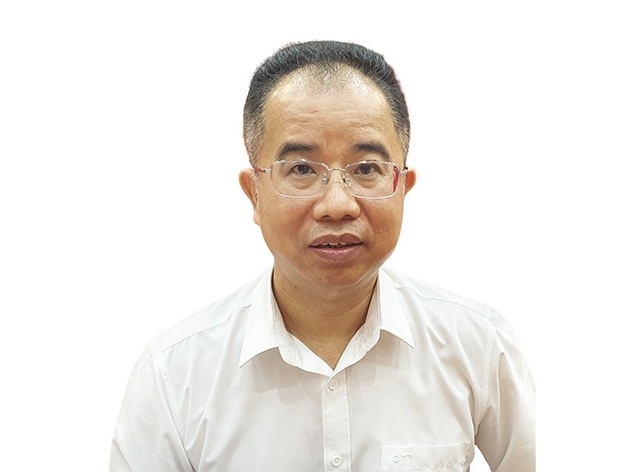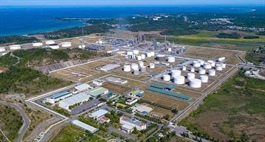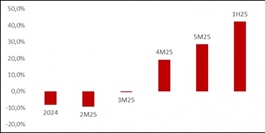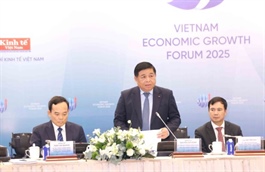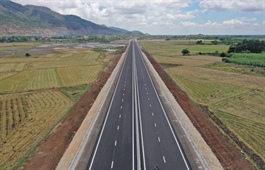MoF outlines key drivers and challenges to growth
MoF outlines key drivers and challenges to growth
As Vietnam aims for one of the region’s most ambitious growth targets, Deputy Minister of Finance Do Thanh Trung weighs in on the path ahead – examining the challenges, opportunities, and strategic moves needed to sustain momentum and power past the 8 per cent mark in 2025.
|
How would you assess the country's recent economic performance in the context of current global challenges?
According to data released by the National Statistics Department under the Ministry of Finance, second-quarter (Q2) GDP expanded by 7.96 per cent, bringing the first-half growth to 7.52 per cent. Both figures are closely aligned with the growth scenario outlined in Resolution No.154/NQ-CP on key tasks and solutions to implement the country’s socioeconomic development plan and the state budget estimate with the growth target of 8 per cent and beyond in 2025.
In my view, this is a very positive performance. The GDP growth rates for both Q2 and the first six months are relatively high compared to recent years. In fact, the first-half growth in 2025 is among the highest recorded in nearly two decades. In a regional context, this pace of growth is likely the highest in ASEAN and ranks among the top globally.
Moreover, we must consider these growth results against the backdrop of the global economic landscape. When we began drafting the 2025 socioeconomic development plan at the end of last year, we already anticipated significant challenges and external uncertainties. However, the difficulties we’re now facing have proven to be even more substantial, arriving rapidly and unpredictably.
Since the beginning of Q2, new developments have continued to emerge – the armed conflict in Ukraine, tensions between Israel and Iran, frictions between Thailand and Cambodia, and the United States’ shifting tariff policies.
All of these have created a volatile global investment and business environment, and have weakened the growth outlook of many economies.
Amid such turbulence, Vietnam has persisted with coordinated and effective policy measures, showing strong determination to drive the economy towards the 8 per cent growth target this year. The result so far is a relatively strong and encouraging.
Beyond GDP, several other macroeconomic indicators are also trending positively. For example, credit growth has improved; state budget revenue in the first six months reached 67.7 per cent of full-year target, up 28.3 per cent on-year. Industrial production, import-export activity, domestic consumption, and public investment disbursement have all shown solid progress. Together, these factors are creating momentum for achieving the 8 per cent growth target and broader socioeconomic goals for 2025.
What are the key challenges and opportunities you see for sustaining strong economic growth in the second half of the year?
Although the economy has recorded inspiring results in the first half of the year, we must acknowledge that achieving the 2025 growth target remains a significant challenge. To reach an annual growth rate of over 8 per cent, the economy must expand by approximately 8.4 to 8.5 per cent in the second half – a steep requirement, especially given the continued global headwinds that could affect Vietnam's economy and society.
Geopolitical conflicts remain complex and unresolved. The US tariff issue is still in flux. Although the US has postponed the tariff implementation date to August 1, and Vietnam has reached some positive agreements with Washington, we must wait for the final outcome before accurately assessing the impact on our economy.
Vietnamese exports are still facing considerable risks. Meanwhile, although domestic consumption is improving, it has yet to show a breakthrough. Private investment is gradually recovering but remains unstable. New growth drivers such as science and technology, digital transformation, financial centres, and free trade zones are still in the early stages and require time to yield tangible results.
Despite these challenges, I believe Vietnam’s economy holds strong potential to accelerate growth through key levers: boosting public investment, stimulating consumption and tourism, increasing contributions from high-tech and digital sectors, advancing the green transition, and capitalising on the ongoing shift of global capital flows into emerging markets.
Since the new two-tier local government model took effect on July 1, how will the policy of assigning growth targets to localities be implemented moving forward?
Indeed, a new approach was introduced this year, with the government assigning regional GDP targets to each locality. In response, local authorities have shown strong commitment and determination, implementing tasks and measures to drive growth.
The results are promising: in Q2, 41 pre-merger localities saw higher growth than in Q1. Over the first six months, 30 localities achieved GDP growth rates above 8 per cent, with several exceeding 10 per cent. Most key economic zones met or surpassed the 8 per cent threshold.
To ensure the effectiveness of this policy following the administrative restructuring, the Ministry of Finance had proposed, and was subsequently assigned by the Prime Minister, to lead efforts in coordination with localities to revise Resolution No.25/NQ-CP, setting the regional GDP growth targets for the 34 newly merged localities in 2025. We are actively working to fulfill this important task.
As of July 1, the consolidation of administrative units from 63 to 34 provinces and centrally run cities, coupled with the implementation of a two-tier local government model, represents a historic and strategic shift.
It opens vast opportunities for more robust national and regional economic development. This reform is not only expected to help Vietnam meet or exceed the 8 per cent growth target this year, but also lay the groundwork for double-digit growth in the years ahead.
What are the most critical policy priorities right now to both sustain growth this year and lay the groundwork for long-term development?
We have repeatedly emphasised a broad set of priorities – from revitalising traditional growth drivers and fostering new engines of growth, to institutional reforms, easing barriers for production and business activities, improving the investment climate, and maintaining macroeconomic stability. The key now lies in resolute, coordinated, and effective implementation of these measures, including medium- and long-term strategies.
In the immediate term, we must remain focused on tariff negotiations with the United States, which will have a significant impact. Equally important is the need to closely monitor international and regional developments to ensure timely and appropriate policy responses.
Domestically, we must keep a close watch on the functioning of the newly established two-tier local government model, as well as the implementation of decentralisation and delegation of authority. It is critical to promptly address any administrative bottlenecks, ensuring there are no disruptions to investment procedures or business operations.
In my view, these are the key solutions we need to act on – not just to drive economic growth this year, but also to build a strong foundation for Vietnam’s development in the years ahead.
- 13:58 10/07/2025



